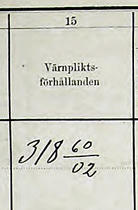

Copyright © Hans Högman 2017-08-10


Enrollment Numbers: 1886 - 1901, 1901 - 1942
Conscription Enrollment
Numbers (Inskrivningsnummer)
Sometimes you will find military enrollment
numbers in the clerical Household Examination Rolls
when you do genealogical research. In the 1800’s,
Sweden had both a standing army consisting of the
allotted and enlisted regiments and reinforcement
troops consisting of draftees (conscripts). This
system of reinforcement troops was called
Beväringen and was a forerunner to the Universal
Conscription System introduced in 1901.
These enrollment numbers were used for the
draftees only and consisted of a three-part
identification number:
The three parts were;
1.
A personal serial number
2.
Roll keeping area (rullföringsområde)
3.
Year of enrollment
In the parliamentary conscription act of 1885
Sweden was divided into 31 registration areas
(inskrivningsområden). These areas were in their turn
divided into battalion, company and local areas. The
registration areas were normally named after the
infantry regiment in the area, for example the
Hälsinge regiment's registration area.
The company areas (kompaniområde) mentioned
above were the actual roll keeping areas (draft
boards) so an registration area (inskrivningsområde)
consisted of several roll keeping areas.
The enrollments were executed by the Draft Board
(inskrivningsnämnden) and supervised by the
Recruitment Auditor (inskrivningsrevisionen).
The enrollments was an registration as well as an
inspection of the young men liable to do military
service and the enrollment rolls were kept during
these inspections.
The enrollment rolls (inskrivningslängderna) contain
information about name, age, place of birth, civil
status and height. You might also find notes
regarding individual recruits. These rolls were called
conscript muster rolls (beväringsmönsterrullor) prior
to 1866 and the rolls starts in 1812.
Enrollment Numbers (Inskrivningsnumer)
1886 - 1901
In 1885 every conscript was assigned a three-part
registration number, the so-called enrollment
number (inskrivningsnummer). As mentioned above
the three parts of the number consisted of; a serial
number, a number for the roll keeping area
(kompaniområde) and year of enrollment and was
written in the form SSS RRR/YY, for example 102
153/92.
In this example, 102 is the serial number for the
individual, 153 is the roll keeping area of the
enrollment and 92 is the year (1892) of the
enrollment. 153 corresponds to Järvsö roll keeping
area within the Hälsinge regiment's registration
area.
The serial number is linked to an individual and is
used to find him in the enrollment roll
(inskrivningslängden) for the specific roll area and the
year in question.
The enrollment roll also contains information about
which army branch the draftee was to do his service
in. If the roll, for example, states Infantry for a
person enrolled within the Hälsinge regiment's
registration area it means that he probably did his
service at the Hälsinge regiment.
Details about the conscripts were
kept in the so-called stamrulla ("stam"
roll).
To the right is an image from a
household examination roll
(husförhörslängd) showing a
conscript enrollment number in the
column "värnpligt".
The Allotment System was abandoned in 1901 and
replaced by a Universal Conscription System. The
earlier 31 registration areas were now replaced by
with 26 areas (from 1926 21 areas). The registration
areas were in turn divided into so-called
"rullföringsområden" (roll keeping areas) for the
Army and "sjörullföringsområden" (Naval roll keeping
areas) for the Navy.
In the text above about enrollment numbers prior to
1901 I have called the company area
(kompaniområde) for roll keeping area in English. In
1901 the new "rullföringsområde" replaced the
earlier "kompaniområde". However both of them
were roll keeping areas, so in English I also will refer
to "rullföringsområde" as roll keeping area.
Enrollment Numbers (Inskrivningsnumer)
1902 - 1942
The three-part enrollment number was retained in
the Universal Conscription System. The number
consisted of a serial number, a number for the
roll keeping area (rullföringsområde) and year of
enrollment and was still written in the form SSS
RRR/YY, for example 120 61/08.
In this example, 120 is the serial number for the
individual, 61 is a number for the roll keeping area
of the enrollment and 08 is the year (1908) of the
enrollment. 61 corresponds to Bollnäs roll area
within the Gävleborg's registration area. After 1901,
the registration areas had in many cases the same
name as the county, i.e. Gävleborg County.
The roll keeping areas were abandoned in 1942 and
the registration areas now handed all the
enrollments. Between 1942 and
1952 the roll keeping areas in the
enrollment number were the same
as the registration areas.
To the right is an image from a
parish book (församlingsbok)
showing a conscript enrollment
number in the column
"värnpliktsförhållanden".
The draft cards (stamkort/värnpliktkort) were
introduced in 1918.
In order to find a person in the enrollment roll it is
important to know which parish he lived in at the
time of the enrollment. The rolls were organized
geographically within each registration area. The
rolls were territorially organized until 1952 and the
assignation to a regiment mostly dependent on the
conscript's home district. If there were several
regiments within the registration area the conscripts
were apportioned to the different regiments.
Normally the infantry needed the most men.
In 1953 the rolls were reorganized according to each
individual's national personal identification number
(personnummer). The rolls were then replaced by the
so-called längdkort (enrollment cards).
Normally you find the enrollment number in the
Household Examination Roll and then of course you
automatically have information about the parish.
In 1953 the enrollment number was replaced with a
national personal identification number (PIN), in
Swedish called "personnummer".
The enrollment rolls are kept at the War Archives
(Krigsarkivet) in Stockholm.
Once you have finished the research of the
enrollment rolls and hopefully found information
about which unit the conscript soldier did his
military service in, you can carry on by looking at
this unit's archives and see if there are any conscript
rolls (värnpliktsrullor) or other documents to study.
Registration Areas and
Enrollment Numbers
The following link refers to a page where you can get
help to interpret an enrollment number
(inskrivningsnummer).
How to interpret the enrollment numbers.
Top of page


Research of Soldiers,
Sweden
Related Links
•
The Allotment System
•
Swedish Regiments
•
Swedish Military Unit Numbers
•
Tutorial: How to Research Soldiers
•
Tutorial: Conscription Enrollment Numbers
•
Example of soldier rolls & documents
•
About the enrollment Numbers (Conscripts)
•
Examples of different notations in general
muster rolls
•
Terms, soldier research
•
The rote numbering of the Södermanland
regiment
Source References
•
Krigsarkivet och släktforskaren, Christopher von
Warnstedt, SSGFs skriftserie, nr 1. 1989.
•
Släktforskaren och Krigsarkivet by Lars Ericsson,
article in Båtsmän, ryttare & soldater, Årsbok
Sveriges Släktforskarförbund 1988.
•
Soldatforska, Lars Ericson Wolke, 2012
•
Soldatforskning, by P Clemensson, L Ericsson, P
Frohnert and B Lippold. Krigsarkivet 1995.
•
Släktforskarna och Krigsarkivet, en vägvisare till
de militära källorna. Message from Krigsarkivet
XIX, 2000.
•
Beståndsöversikt Krigsarkivet
•
Inskrivningar av värnpliktiga 1812 - 1969, en
översikt av Evabritta Personne, 1968.
•
My own experiences
Top of page













